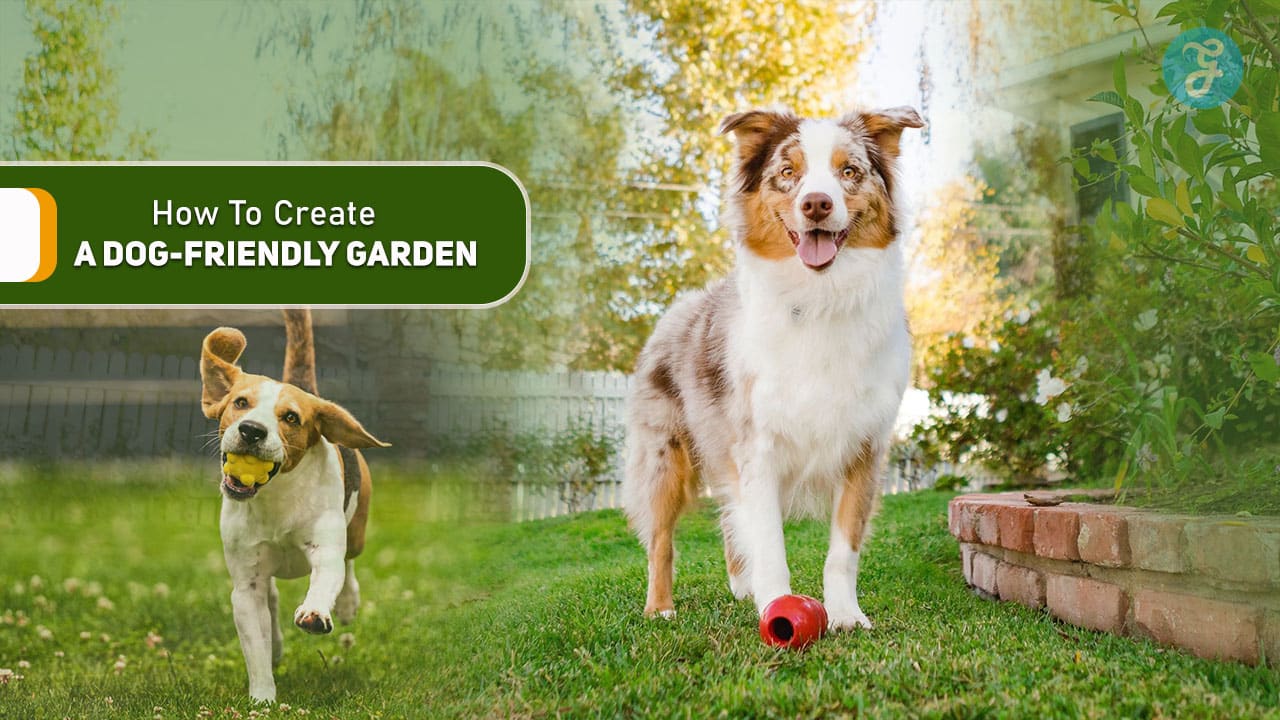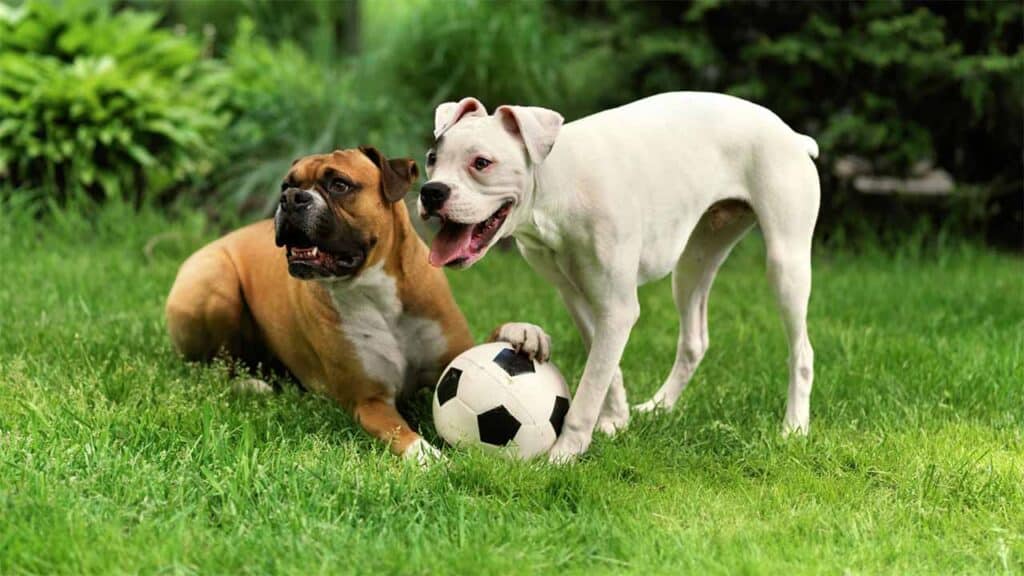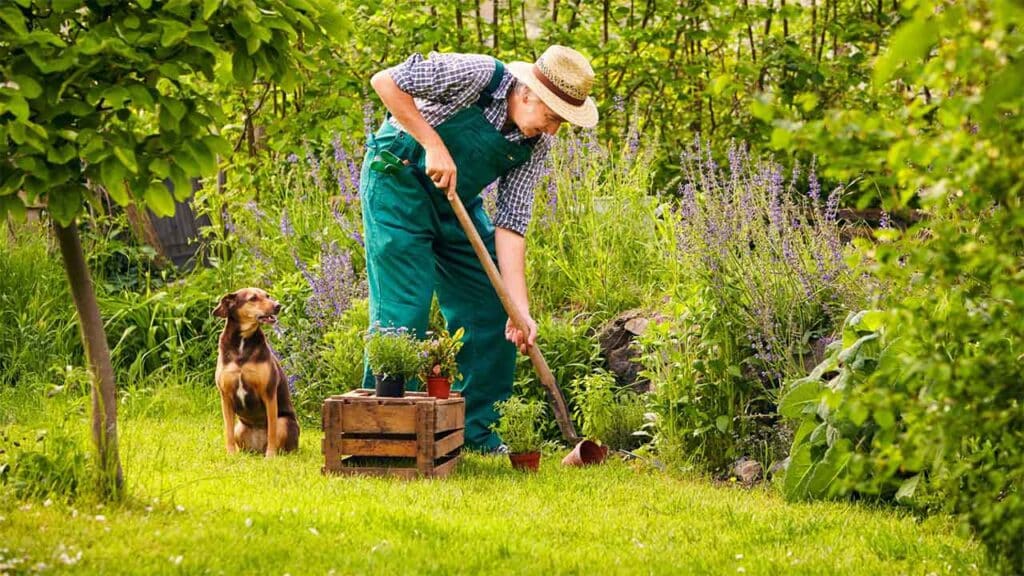Creating a dog-friendly garden requires more than just adding greenery and decorative elements; it involves designing a safe, fun, and enriching space for your dog while maintaining the beauty and functionality of your garden.
Dogs, by nature, are curious and active; without proper planning, they may trample plants, dig up flower beds, or chew on harmful vegetation. Whether you’re an experienced gardener or just starting, crafting a garden that accommodates your dog’s needs will prevent damage and provide a space for your pet to explore, play, and relax safely.
This article will explore ten essential tips to transform your outdoor space into a dog-friendly haven, from choosing non-toxic plants to installing dog-friendly surfaces and sensory gardens.
With a few adjustments, your garden can become a shared space where you and your dog can thrive together.
1. Choose Non-Toxic Plants
When designing a dog-friendly garden, one of the first considerations is ensuring that all plants in the area are safe for your dog. Many plants commonly found in gardens can be toxic to dogs if ingested, and it’s essential to be aware of which ones to avoid.
Some plants, like daffodils, tulips, and lilies, may add vibrant colour to your garden, but they pose serious health risks to your dog. Ingesting parts of these plants can cause symptoms ranging from mild gastrointestinal distress to more severe reactions, including kidney failure or even death.
Therefore, it’s essential to research and select pet-safe plants. Consider using sunflowers, roses, and snapdragons, which are non-toxic to dogs and still bring beauty and texture to your garden.
Additionally, think about where you’re placing your plants. Safe plants are better suited to elevated positions, such as hanging baskets or raised beds, to reduce the likelihood of your dog chewing on them.
Regularly inspect your garden for plants that may have grown in from neighbouring properties or fallen seeds that could be harmful. Taking these steps will ensure that your garden is beautiful and a safe environment for your pet to explore and enjoy.
2. Create Designated Play Areas
Dogs love to play, and without a designated play area in the garden, they may end up trampling through your flower beds or damaging delicate plants. A thoughtfully designed play space can encourage your dog to run, dig, and frolic without wreaking havoc on the rest of your garden.
Start by selecting an area of your garden with enough space for your dog to move freely. You can use durable grass or artificial turf, which are soft on paws and easy to clean. If your dog loves to dig, consider creating a specific area filled with soft soil or sand.
This will give them an outlet for their instincts while keeping them away from your prized plants. You can even bury toys or treats in the sand to make the area more enticing. Another fun addition to the play area is an obstacle course with jumps or tunnels for entertainment.
Including smooth pavers or gravel, pathways can help guide your dog around the garden, further protecting sensitive plants. By creating a designated play zone, you protect your garden and give your dog a fun and stimulating outdoor environment to enjoy.
3. Add Safe Fencing
Safety should be a top priority when designing a dog-friendly garden, and one of the most crucial elements is fencing. A secure, well-built fence will keep your dog safe within the garden and prevent them from wandering off into potentially dangerous situations.
The height and material of your fence should be tailored to your dog’s size and temperament. For instance, large, athletic dogs may need fences at least 6 feet tall to prevent them from jumping over. Additionally, some dogs may be skilled diggers, so it’s essential to ensure that the fence extends below ground or that barriers are in place to prevent your dog from digging their way out.
Chain-link or wooden fences are often sturdy options, but ensure they don’t have gaps or weak spots that your dog could squeeze through. If you’re concerned about the appearance of a tall fence, you can plant hedges or vines along it to soften the look while maintaining security.
Make sure your dog cannot easily push open gates and that they are always properly latches. Ensuring your garden is fully enclosed gives you and your dog peace of mind, allowing them to explore freely without running into the street or a neighbour’s yard.
4. Provide Shade and Water
A dog-friendly garden isn’t complete without spaces for your dog to rest, cool down, and hydrate—especially on hot days. Dogs can quickly overheat while playing and running around in the garden, so providing shaded areas where they can take a break is essential.
You can create these incredible, relaxing spots by planting trees or adding a pergola, awning, or large umbrella that provides consistent shade throughout the day. If you prefer a more natural look, consider planting tall shrubs or installing trees with climbing plants to create shaded nooks.
In addition to shade, always ensure your dog has access to fresh water. Placing a water bowl or a small dog-friendly water fountain in the shaded area can make a big difference. Some garden fountains or water features double as a source of drinking water and play, keeping your dog hydrated while adding a touch of style to your garden.
For added fun, a splash zone with a sprinkler or shallow pool can help your dog cool off while playing. Remember that your dog relies on you to provide these essentials, so check the water levels frequently and refresh them as needed.
Creating shaded and well-watered spaces will help keep your dog comfortable and healthy as they enjoy the outdoors.
5. Use Dog-Friendly Mulch
Mulch is an excellent gardening tool, helping retain soil moisture, regulate temperature, and suppress weeds. However, not all mulches are safe for dogs. Some commonly used types, such as cocoa mulch, can be toxic to pets, as it contains theobromine—the same chemical found in chocolate.
Ingesting this mulch can result in symptoms ranging from mild digestive upset to more severe issues like seizures. Fortunately, safer alternatives can still help your garden thrive while keeping your dog out of harm’s way. For example, pine bark and cedar chips are both pet-safe mulches that add a lovely aesthetic to your garden.
Cedar chips even have the added benefit of repelling insects. Another option is using rubber mulch made from recycled materials, which is long-lasting and durable, although it’s best suited for play areas rather than around delicate plants.
No matter which mulch you choose, always keep an eye on your dog to ensure they aren’t ingesting large amounts, as even non-toxic mulch can cause stomach upset if consumed in excess.
Spread mulch evenly and avoid placing it in areas where your dog frequently digs or rests to minimize accidental ingestion.
6. Build Raised Beds
Building raised beds is an excellent solution if you’re worried about your dog trampling through your plants or digging up your garden. Raised beds create a natural barrier protecting your plants while allowing your dog to roam freely around the garden.
These elevated garden boxes keep plants safe from curious paws and make it easier for you to maintain and care for your garden. Raised beds come in various heights and materials, such as wood, brick, or stone, which can add an attractive feature to your outdoor space.
You can even build them yourself if you’re handy with DIY projects. In addition to protecting your plants, raised beds can help define specific areas of your garden, creating a sense of structure and organisation. For extra protection, consider adding small decorative fences or mesh netting around the raised beds to deter dogs from getting too close.
If your dog enjoys lounging in the garden, you can create a small raised platform specifically for them, ensuring they have their designated space without disturbing your plants. You can balance a flourishing garden and a dog-friendly outdoor environment with raised beds.
7. Provide Entertainment
A bored dog can quickly become destructive, so keeping your pet entertained is critical to maintaining a peaceful and beautiful garden. Providing stimulating activities and toys for your dog will help prevent them from digging, chewing, or trampling on your plants. Start by incorporating interactive toys that engage your dog’s mind and body.
Puzzle toys that dispense treats can keep your dog occupied for extended periods, while squeaky toys or tug ropes offer opportunities for physical play. If your dog enjoys running and jumping, consider setting up a mini agility course with hurdles, tunnels, or hoops.
These provide great exercise and challenge your dog mentally, making them less likely to engage in unwanted behaviours. Another fun idea is creating a sensory garden for your dog, with different textures to explore and scents to sniff.
You can plant herbs like mint or basil, which are safe for dogs and provide an enriching experience. Finally, playing with your dog in the garden is a great way to bond and burn off their energy.
By offering engaging entertainment, you’ll help your dog stay active and content while preserving the integrity of your garden.
8. Install Soft Surfaces for Paws
The surfaces in your garden play a significant role in your dog’s comfort and safety. Some materials, like rough gravel or sharp stones, can be hard on a dog’s sensitive paws and may even cause injuries.
When creating a dog-friendly garden, choosing surfaces that are gentle and safe for your pet is essential. Grass is one of the best options, providing a soft, natural surface that dogs love to run and play on. However, maintaining a lush lawn can be challenging, especially if your dog is active.
In this case, artificial turf might be a suitable alternative. It offers the same softness as grass but requires less maintenance and holds up well to wear and tear. Smooth pavers or rounded gravel can also be used for pathways, creating a stable and comfortable surface for your dog to walk on.
Avoid using sharp or jagged stones, which can cause cuts or discomfort. If your garden includes a deck or patio, consider adding outdoor rugs or mats to provide a softer walking surface. By installing pet-friendly surfaces, you’ll protect your dog’s paws and create a more inviting environment for them to explore.
9. Create a Dog-Friendly Sensory Garden
A sensory garden explicitly designed for your dog can provide hours of entertainment and enrichment. Dogs experience the world primarily through their sense of smell, and a garden filled with various scents, textures, and sounds will stimulate their senses and keep them engaged.
Start by planting dog-safe aromatic herbs and flowers, such as lavender, mint, and rosemary. These plants offer enticing smells that encourage your dog to sniff and explore. In addition to scent, consider incorporating different textures in your garden, such as soft grass, bark, and smooth pebbles.
These variations will give your dog a range of surfaces to interact with, adding to their sensory experience. A gentle water feature, such as a bubbling fountain or small pond, can provide soothing sounds that help your dog relax while also serving as a source of drinking water.
You can also create a sandpit or use soft soil in certain areas to encourage digging. Sensory gardens are not only fun for dogs but can also have calming effects, helping to reduce anxiety and boredom. Focusing on sensory elements will create a dynamic and stimulating environment for your dog.
10. Be Mindful of Chemicals and Pesticides
Keeping your garden healthy and pest-free is essential, but many commercial pesticides, herbicides, and fertilisers contain chemicals that can harm dogs. Ingesting or even coming into contact with these substances can lead to serious health issues, including gastrointestinal upset, poisoning, or skin irritation.
To ensure your garden is a safe haven for your dog, choosing pet-friendly alternatives is essential. Organic fertilisers made from compost or natural ingredients are safer for your garden and your dog. For pest control, consider using natural remedies such as neem oil, diatomaceous earth, or homemade insecticidal soap, which are eco-friendly for pets.
Another good practice is to fence off or block access to areas where you’ve recently applied treatments, giving the chemicals time to absorb or dissipate before allowing your dog to roam freely.
Always store gardening chemicals in a secure location out of your dog’s reach, and read product labels carefully to ensure they are safe for use in pet-friendly gardens. Opting for non-toxic solutions will keep your dog healthy and happy while maintaining a thriving garden.
Summary
Designing a dog-friendly garden is about protecting your plants and creating an environment where your dog feels safe, engaged, and happy. Considering factors like plant safety, play areas, comfortable surfaces, and sensory elements, you can ensure that your outdoor space meets your dog’s needs without sacrificing beauty or functionality.
With careful planning and thoughtful design, your garden can become a place where you and your furry friend enjoy spending time.
By integrating these ideas into your garden, you’ll create a space that nurtures your dog’s instincts, provides plenty of opportunities for play and relaxation, and contributes to their overall well-being. After all, a well-designed garden is a pleasure and joy to live with your loyal companion.






































